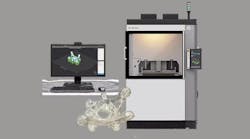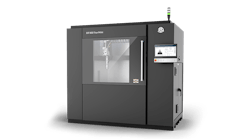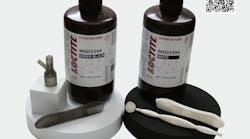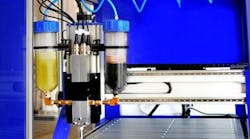DMG MORI has further developed its CELOS control and user interface to create an open and consistent ecosystem for digital production. In the current CELOS version, the focus is on digital workflows for adaptive production planning and integrated tool management. DMG MORI’s current digitization initiatives are based on the vision of the digital factory, which is characterized by adaptive factory structures. The digital factory’s key feature is the automatic, data-based adaptation of processes in production to changing framework conditions.
The major focus of the CELOS Ecosystem is its “Open Connectivity” which enables CELOS network integration with machines from other manufacturers, machines in complementary technological areas and manual workstations. Even older machines have to be connected to a certain degree. “This means that, soon, almost any machine and any workstation can be upgraded to become a member of the CELOS network, and this in turn opens up completely new levels of freedom to our customers with regard to optimizing their digital workflows,” promises Dr. Holger Rudzio, the Managing Director of DMG MORI Software Solutions GmbH.
Three U.S. Premieres:
Two US Premieres – two of the largest machining centers in Gantry design
DMG MORI has expanded its portfolio and will be premiering for the first time in the U.S. at IMTS, two XXL machines: the DMU 200 Gantry and DMU 340 Gantry. The machines of the Gantry series have been specifically developed for highly dynamic universal applications of large components. Both models offer 5-axis simultaneous machining on the largest work area with the smallest space requirement.
The DMU 200 Gantry impressively combines the machining of large components and maximum dynamics and improves user benefits in the aerospace and automotive industry as well as in mold making and the energy sector. With the 5-axis machining of up to 30,000 rpm and optional ULTRASONIC or LASERTEC technology integration, more complex components weighing up to 22,046 lbs made of aluminium or composites as well as welded components can be machined economically.
The DMU 340 Gantry impresses with its top gantry design that makes this machining center powerful, dynamic and universally applicable. This new machining center is the impressive result of an in-depth liaison with the large component manufacturers from the aerospace industry, general mechanical engineering as well as tool and mold manufacturing. The work area of the DMU 340 Gantry measures 134 x 110 x 49 in and provides expansion options to up to 236 in. in the X- and 59 in. in the Z-axis. Due to its gantry design, it also has compact dimensions.
One US Premiere – high-performing basic turning machine for the automotive industry
Modern equipment options, compact dimensions and a high level of automation are all decisive for the efficiency of a turning machine. DMG MORI has taken this into account in the development of the new ALX 2500, so customers from the automotive and other demanding branches such as general mechanical engineering have a model available that meets the high demands of serial production. On barely 52.6 ft², the stable, dynamic turning machine offers perfect ergonomic design for operation and maintenance by uniting excellent standards from a max. spindle speed of 3,500 min-1 to the BMT turret with twelve powered tools and tailstock. In addition, the ALX 2500 provides a high degree of automation thanks to the optional gantry loader, a factor decisive for cost effectiveness in production.
At IMTS this year, DMG MORI will be presenting the NHX 4000 3rd Generation machining center with a 21 RPP rotary pallet pool feature. With a spindle speed of 20,000 rpm, a power rating of 50 hp and a maximum torque of 163 ft lbs, it ranks among the best on the market. Added to this is a 36-month warranty that DMG MORI provides for all its own MASTER spindles – with no runtime limitation. Standard auto coupler hydraulic fixture interface enables the NHX 4000 3rd Generation to automate in a more efficient manner. This horizontal machining center handles workpieces up to 882 lbs and is ideally equipped for ensuring flexible and economic production thanks to its extensive range of machine and automation options.
The NHX 6300 2nd Generation is equipped with a standard 12,000 rpm, 75 hp powerMASTER spindle with maximum torque of 595 ft lbs. An optional high-speed version from the powerMASTER spindle range has a maximum speed of 16,000 rpm and up to 1,042 ft lbs of torque for demanding heavy-duty machining. The NHX 6300 2nd Generation offers space for pallets up to 25 x 25 inches, a workpiece height of 51 inches, and maximum loading capacity of 3307 lbs. By using a FANUC control, DMG MORI has managed to considerably reduce the throughput times of this horizontal milling machine.
The CMX 1100 V vertical machining center is also produced locally in Davis, California. This machine enables workpiece weights of up to 2,205 lbs and provides a travel path up to 43.3 x 22 x 20.2 in. Rapid traverses are 1,417 in/m in X- and Y-axes, and 1,181 in/m in Z. The CMX 1100 V will be featured with a speedMASTER 20,000 rpm spindle with 50 hp and 163 ft lbs of torque paired with the MATRIS modular robot automation at IMTS. This high-performance spindle is designed for broad applications, continuous-operation durability and achieves high-quality manufacturing results.
Automation – from a single source – heading towards future-oriented production with standardized and individual automation solutions
Another focus of the development work is automation. It is the aim of DMG MORI that every machine in the wide and varied portfolio can be equipped with an automation option in future. Intelligent linking of the machine tool and automation is a key focus at the production locations in order to ensure customers can receive their automation solution from a single source.
At IMTS, the machine tool manufacturer will be presenting the proven PH 150 pallet handling system, LPP multi-layer pallet pool system, 21 RPP space-saving automation solution, as well as the newly developed, flexible GX gantry loader in the new VERTICO design. Robo2Go 2nd Generation extends the portfolio as a mobile robotic automation system for a large number of turning machines. Integrated turnkey offers that link any number of machines and process-supporting work steps complete the automation range from DMG MORI.
With its Robo2Go 2nd Generation, DMG MORI also has a workpiece handling solution in its range which can be put to flexible use on a number of universal turning machines and which cuts an impressive figure as it is easy to program with CELOS. This year, the CTX beta 800 will demonstrate its easy teach-in functions for different work pieces and flexible setup at multiple turning machines.
DMG MORI also creates larger manufacturing cells comprising of several machines using linear pallet pools (LPPs) and robotic automation systems. The LPP feature provides the most flexible, multi-layer pallet pool systems with up to 8 machines, 99 pallet and 5 setup stations. The NHX 6300 2nd generation automation solution demonstrates the handling of up to 3 different sizes of pallets possible in one system.
“Automated machine tools as a part of future-oriented production guarantee users a high degree of competitiveness,” affirms Alfred Geißler, the Managing Director of DECKEL MAHO Pfronten GmbH. He then goes on to explain that this is precisely why DMG MORI has helped its customers to create the best possible automation solution for every application. “This applies to almost all manufacturing companies nowadays – from small contract suppliers to global players.” After all, he adds, every market participant is competing in a global environment.
The reasons for automation are as diverse as the possible automation solutions. Cost effectiveness, flexibility and reliability are just three examples of the possible benefits. “Only an automation solution has a higher level of repeat accuracy than any manual workpiece clamping and unclamping operation,” Harry Junger, Managing Director of GILDEMEISTER Drehmaschinen GmbH, explains providing an example.
ADDITIVE MANUFACTURING – manufacturing of 3D components in finished part quality
DMG MORI has already been operating successfully in the market for ADDITIVE MANUFACTURING since 2013 with directed energy deposition using powder nozzle technology. With its deposition-to-finishing competence, DMG MORI presents the most important additive manufacturing machining processes under one roof and ranks as a full-solution provider in both the additive production of metallic components and metal cutting. The highlight that will be featured at IMTS this year is the LASERTEC 30 SLM.
With the powder bed technique, very small, highly complex parts can be manufactured by means of selective laser melting. The LASERTEC 30 SLM enables the flexible use of different materials, while an intelligent powder module concept allows the change of material in under two hours. The closed powder circuit also guarantees a high degree of work safety and process autonomy. The ergonomic design of the machine simplifies workpiece handling and maintenance work through the arrangement of doors and flaps, while the new Stealth Design Control Panel keeps all important buttons and operating elements in direct view and control panel.
The LASERTEC 30 SLM enables holistic software solutions to realize workpieces of various materials with high density and very good mechanical behaviors. This selective laser melting machine produces 3D parts with lattice and honeycomb structures which are not achievable with other machining methods. It has an integrated powder recycling center for even more efficiency and improved powder handling in removable units for better reliability.
DMG MORI relies on its own machining centers for the finishing of workpieces from the powder bed. “With the LASERTEC 30 SLM, we have brought powder bed technology out of the laboratory environment and into the sphere of industrial production. This machine is an ‘enabler’ of technology,” explains Fred Carter, Lead Engineer of DMG MORI’s Advanced Solutions, Inc. This applies to both the hardware and the software. “Integral processes are the overarching goal.”





